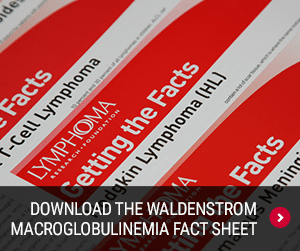
What is Lymphoma?
Waldenström Macroglobulinemia
Waldenström macroglobulinemia (WM), which is a subtype of lymphoplasmacytic lymphoma, is a rare indolent (slow-growing) B-cell lymphoma that occurs in less than two percent of patients with non-Hodgkin lymphoma (NHL). There are about 5,000 new cases of WM diagnosed each year in the United States. The disease usually affects older adults and is primarily found in the bone marrow, although lymph nodes and the spleen may be involved. Lymphoma cells in the bone marrow grow and block normal cells, making it difficult for the bone marrow to produce normal amounts of red and white blood cells. This can result in anemia (low levels of red blood cells), neutropenia (low levels of white blood cells called neutrophils), and thrombocytopenia (low levels of platelets).
Patients with WM have a high level of a protein called immunoglobulin M (IgM) in their blood, which can cause hyperviscosity (thickening of the blood).
To diagnose WM, blood and urine tests are usually performed, as well as a bone marrow biopsy.
Download the Waldenström Macroglobulinemia Fact Sheet
Learn more about Waldenström macroglobulinemia and treatment options.
To learn more about a specific type of lymphoma, select from the following menu:
- Adolescent and Young Adult Lymphoma
- Adult T-Cell Leukemia/Lymphoma
- Anaplastic Large Cell Lymphoma
- Angioimmunoblastic T-Cell Lymphoma
- Burkitt Lymphoma
- Central Nervous System Lymphoma
- Chronic Lymphocytic Leukemia
- Cutaneous B-Cell Lymphoma
- Cutaneous T-Cell Lymphoma
- Diffuse Large B-Cell Lymphoma
- Follicular Lymphoma
- High Grade B-Cell Lymphoma
- Hodgkin Lymphoma
- Mantle Cell Lymphoma
- Marginal Zone Lymphoma
- Non-Hodgkin Lymphoma
- Peripheral T-Cell Lymphoma
- T-Cell Lymphoma
- Transformed Lymphomas
- Waldenstrom Macroglobulinemia


